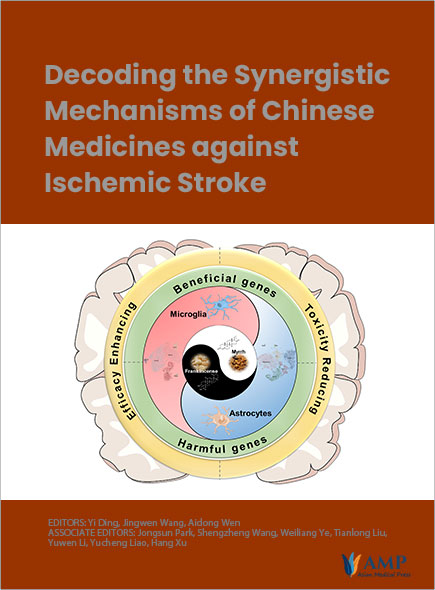Decoding the Synergistic Mechanisms of Chinese Medicines against Ischemic Stroke

Publisher: Asian Medical Press Ltd; 1st edition (2024)
ISBN-13: 978-1-0687236-0-5
Hardcover: 93 pages
Language: English
Available at: Being Sent to Amazon
Yi Ding1, Jingwen Wang1, Aidong Wen1
1. Department of Pharmacy, Xijing Hospital, Fourth Military Medical University, Xi'an 710032, China.
Jongsun Park1, Shengzheng Wang2, Weiliang Ye3, Tianlong Liu4, Yuwen Li5, Yucheng Liao6, Wenjun Wang7, Hang Xu8
1. Department of Pharmacology, College of Medicine, Chungnam National University, Daejeon, 35015 South Korea.
2. Department of Medicinal Chemistry and Pharmaceutical Analysis, School of Pharmacy, Fourth Military Medical University, Xi’an 710032, China.
3. Department of Pharmaceutics, School of Pharmacy, Fourth Military Medical University, Xi’an 710032, China.
4. Department of Pharmacy, The 940th Hospital Joint Logistics Support Forces of PLA, Lanzhou 730050, China.
5. Department of Pharmacy, West China Hospital, Sichuan University, Chengdu 610041, China.
6. Department of Pharmacy, Xijing Hospital, Fourth Military Medical University, Xi’an 710032, China.
7. State Key Laboratory of Southwestern Chinese Medicine Resources, College of Ethnic Medicine, Chengdu University of Traditional Chinese Medicine, Chengdu 611137, China.
8. Department of Pharmacy, Xijing 986 Hospital, Fourth Military Medical University, Xi’an 710032, China.
Differential gene expression profiles between two subtypes of ischemic stroke with blood stasis syndromes
Tian-Long Liu, Min-Na Liu, Xin-Liang Xu, Wen-Xing Liu, Pei-Jin Shang, Xiao-Hu Zhai, et al.
1-13
Novel patterns for drug synergistic mechanism research
Tian-Long Liu, Min-Na Liu, Yi Ding
14-17
Study on syndrome differentiation based on pharmacology of syndrome management system - a case of Qi and Yin deficiency syndrome
Wen-Jun Wang, Shao-Jie Huang, Juan-Li Zhang, Yang Ma, Fei Mu, Yu-Cheng Liao, et al.
18-25
Study on the multi-targets mechanism of triphala on cardio-cerebral vascular diseases based on network pharmacology
Wen-Jun Wang, Shao-Jie Huang, Juan-Li Zhang, Yang Ma, Fei Mu, Yu-Cheng Liao, et al.
26-36
Investigation of the multi-target mechanism of Guanxin-Shutong Capsule in cerebrovascular diseases: a systems pharmacology and experimental assessment
Juan-Li Zhang, Jia-Xin Zhao, Yang Ma, Wen-Jun Wang, Shao-Jie Huang, Chao Guo, et al.
37-49
Combination of systems pharmacology and experimental evaluation to explore the mechanism of synergistic action of Frankincense-Myrrh in the treatment of cerebrovascular diseases
Yu-Cheng Liao, Jing-Wen Wang, Chao Guo, Min Bai, Bo-Wei Ju, Zheng Ran, et al.
50-61
A network pharmacology technique to investigate the synergistic mechanisms of Salvia Miltiorrhiza and Radix Puerariae in treatment of cardio-cerebral vascular diseases
Yang Ma,Wen-Jun Wang, Jia-Ni Yang, Sha Zhang, Zhe Li, Fei Li, et al.
62-78
Synergistic neuroprotective effects of Danshensu and Hydroxysafflor Yellow A on cerebral ischemia-reperfusion injury in rats
Hang Xu, Wen-Xing Liu, Tian-Long Liu, Ning Su, Chao Guo, Xiao-Na Feng, et al.
79-86
As the principal investigator of the pharmacy department at Xijing Hospital, my team and I have embarked on an enlightening journey exploring the intricate world of traditional Chinese medicine (TCM) and its integration with contemporary medical practices, specifically targeting cardio-cerebral vascular diseases. This book is a compilation of our rigorous research, findings, and insights, encapsulated into nine pivotal studies that shed light on the mechanistic pathways and therapeutic potential of Chinese herbal compounds and their synergistic effects.
In a progressive exploration of novel drug synergistic mechanisms, this book expands the horizons of multi-target therapeutic strategies. By embracing the complexity of diseases and the multifaceted nature of TCM formulations, we unveil patterns and pathways that could revolutionize the treatment of cardio-cerebral vascular ailments. Through the lens of network pharmacology, we dissect the interactions and impacts of Triphala, Guanxin-Shutong Capsule, and other pivotal compounds, offering a comprehensive view of their potential in combating these diseases.
A significant portion of our research is dedicated to demonstrating the synergistic neuroprotective effects of Danshensu and Hydroxysafflor Yellow A, as well as the broad-spectrum benefits of Resveratrol. These studies underscore the potential of natural compounds to mitigate cerebral ischemia-reperfusion injuries and neurodegenerative diseases, showcasing the power of TCM in addressing complex health issues.
This book is not merely a collection of research findings; it is a clarion call for the modernization of TCM and a deeper integration of Eastern and Western medical practices. By detailing the mechanisms and effects of Chinese herbal compounds in a language that bridges cultures and disciplines, we aim to foster a greater understanding and appreciation of TCM's potential in contemporary medicine. Our journey through this research has been both enlightening and humbling, revealing the profound potential of combining traditional insights with modern scientific approaches.
As we share our discoveries and insights, our ultimate goal is to contribute to the advancement of medical science and the betterment of patient care worldwide. This book is an invitation to medical professionals, researchers, and scholars to explore the rich tapestry of TCM and its applications in modern pharmacology. Together, we can pave the way for innovative treatments that harness the best of both worlds, offering new hope and healing pathways for those suffering from cardio-cerebral vascular diseases and beyond.
Yi Ding
Department of Pharmacy, Xijing Hospital, Fourth Military Medical University, Xi'an 710032, China

 Submit Manuscript
Submit Manuscript